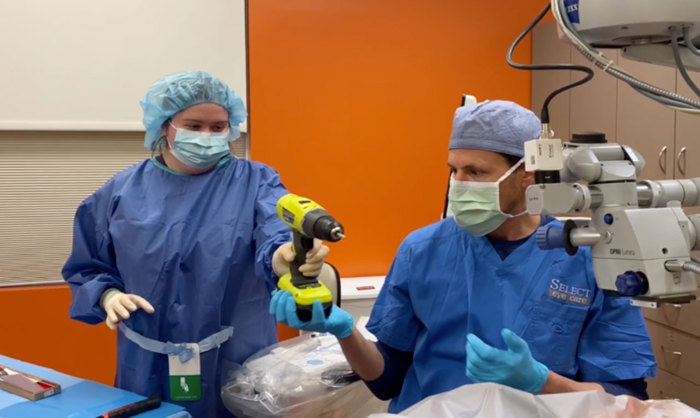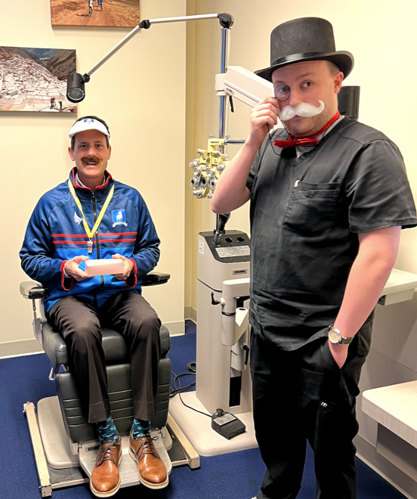
Let’s think about what it takes to get to work: You set your alarm, brew the coffee, fuel/charge the car, make sure the dog got breakfast and fight traffic to hopefully arrive at the office on time. But the moment you step into the office, reality hits hard. Suddenly, you are faced with expectations, responsibilities, intense moments and the constant reminder that there is no room for errors.
The intensity of the surgeon’s job does not necessarily need to spill over into your being at work. How can you shift how your office feels while doing your job? How do you transform the office from just a place to punch the clock into a space you and your staff actually want to be in? It is all about shifting the work mentality! This requires a deliberate effort — and sometimes, just a bit of ridiculousness.
You Might As Well Enjoy the Ride
Let’s do the math: over the next 25 or so years, you will spend more waking hours at the workplace than you will with your loved ones at home. This realization should inspire you to cultivate an office culture that is not only productive, but also balanced, with a sense of enjoyment and fulfillment. At the end of your career, you will not recall how many patients you saw, the number of procedures you performed or how late you left the office each day. You will remember the personal interactions, the relationships you build, and how you felt while at work. That’s why our office motto encapsulates our commitment to professional achievements and personal well-being: “We all have to work and be here, so let’s be happy, smile and enjoy work — darn it.”
Your Path, Your Way
You can find countless tips online for engaging with your staff, such as holding more meetings, conducting surveys, recognizing great work, etc. While these ideas have value, genuinely transforming your work environment into a place people want to be requires a bit more creativity and effort. The best approach is to forge a path that reflects your personality and leverages your strengths. For me, that meant embracing a sense of fun and a bit of ridiculousness.
For example, our clinical team participated in a film festival meant to highlight surgical success stories. Our video submissions included costumes, skateboarding and power tools in the operating room (Figures 1 & 2). We had a blast creating these videos and didn’t mind that they never won any awards.
Another fun distraction from work can be found in our lunchroom, where we’re growing Meyer lemon trees and orange trees. When they bloom, someone reluctantly puts on a bee costume to pollinate them — because, after all, we don’t have actual bees buzzing around inside the office.
By stepping outside the typical “doctor” persona, I’ve intentionally and strategically created an atmosphere in which staff feel more comfortable and connected to our mission. When your team sees different facets of who you are, they are also encouraged to express themselves. Over time, you will have a workplace that inspires creativity and collaboration.

Work Is a Race With No Finish Line
Last week, before work, I had the pleasure of racing Si’Onnie, our testing technician, in the parking lot behind the office. At just 26 years old, she challenged me — her 56-year-old boss, to a foot race. For three weeks, the office buzzed with friendly trash talk. Some staff helped Si’Onnie train, and bets were placed. Our front office manager even brought pom-poms to cheer us on.
Who won? The outcome didn’t matter; what mattered was that, after the race, we gathered for lunch as a team. The experience highlighted an important lesson: a top-down mentality can stifle innovation and potentially harm patient care. We attempt to foster a culture where all staff feel empowered. Embracing input and welcoming challenges from everyone are essential to creating the best possible practice.
Working on Making Work Not Feel Like Work
Preserving and improving vision is a mission that we take seriously. Our office staff is dedicated, compassionate and efficient, ensuring our patients receive the highest-quality care. Beyond their professional interactions, however, our team shows camaraderie through humor and lightheartedness. This sense of connection is a powerful counterbalance to the negativity that can often cloud an office’s energy. By embracing a culture of positivity, we create a more supportive atmosphere that benefits both staff and patients. Doing so leaves less room for complaints and petty issues, allowing us to focus on what truly matters: providing exceptional care.
Working on this article, I had a great idea for our office: to remind staff to “Welcome the Fun,” I will frame signs and put them up all over the office. However, I’ll use the initials to keep our saying among the staff: WTF. OM









